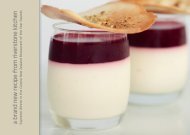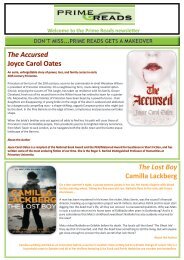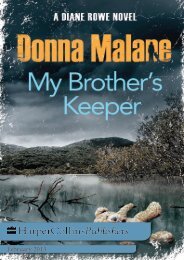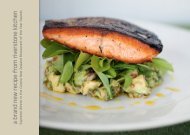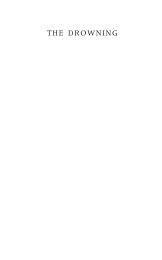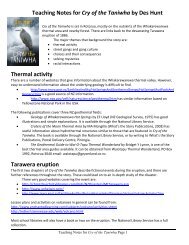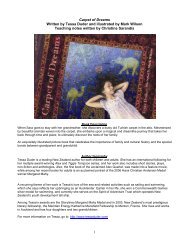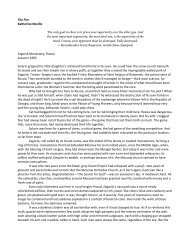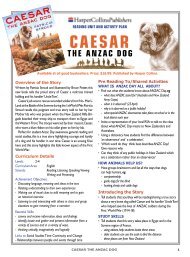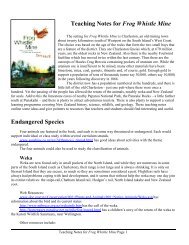Peco Incident - Harper Collins New Zealand
Peco Incident - Harper Collins New Zealand
Peco Incident - Harper Collins New Zealand
Create successful ePaper yourself
Turn your PDF publications into a flip-book with our unique Google optimized e-Paper software.
Teachers Notes for The <strong>Peco</strong> <strong>Incident</strong><br />
The <strong>Peco</strong> <strong>Incident</strong> is set on the Otago Peninsula, near Dunedin, <strong>New</strong> <strong>Zealand</strong>.<br />
The major themes that background the story are:<br />
• Bird viruses<br />
• Battery farming of hens<br />
• Biosecurity<br />
• Eco-terrorism<br />
• Hyperactive kids<br />
• Albatrosses and penguins on the Otago Peninsula<br />
What are viruses<br />
Viruses have an influence on all lives. For many of us they are the cause of the most frequent<br />
illness we get — the common cold and, more infrequently, influenza. The information given<br />
here along with the activities suggested may help children understand what is happening<br />
when they next suffer from a viral infection.<br />
Because they cause disease, viruses are often grouped along with bacteria and fungi as germs.<br />
However, they are very different things. Bacteria and fungi are made up of cells and are<br />
capable of existing by themselves. Viruses are not made of cells and cannot carry out any life<br />
processes without the help of a living organism. Reproduction is the only life process that<br />
occurs with a virus and that has to be done within a living cell.<br />
The influenza virus is modelled below.<br />
Envelope<br />
Hemagglutinin<br />
Neuraminidase<br />
RNA<br />
The two types of structures sticking out from the sphere — hemagglutinin (H) and<br />
neuraminidase (N) — are the proteins used to attach to the cell. They determine what sort of<br />
cell they can attach to, that is, what sort of animal. There can be 16 different types of H and 9<br />
different types of N. We label the strain of a virus using an HxNy code where x and y are the<br />
type of H and N. For example, the swine flu of 2009 was H1N1. H5N1 was the bird flu of<br />
2004. The bird flu in The <strong>Peco</strong> <strong>Incident</strong> is H6N3.<br />
Teaching Notes for The <strong>Peco</strong> <strong>Incident</strong> Page 1
If a virus enters the right sort of animal, it will be able to attach to a cell. The envelope then<br />
opens and the eight strands of RNA enter the cell. They take over the cell and cause it to<br />
construct viruses instead of doing its usual job. A single cell can make lots of viruses before it<br />
uses up all its resources and dies. The viruses escape and infect other cells. And so it goes on.<br />
Some of the viruses will escape from the first host and attack others.<br />
V i r u s a c t i v i t i e s<br />
Modelling a virus<br />
Students could use a range of waste products to make models of a virus. The bottoms of<br />
plastic drink bottles could be joined together to make the envelope. Strands of string or wool<br />
could represent the RNA. The H and N bits don’t need to look like those in the diagram. They<br />
can be any shape.<br />
Strains<br />
The strain of a virus is determined by the H and N as well as the strands of RNA inside. With<br />
16 different types of H and 9 different types of N, how many different HxNy strains could<br />
there be?<br />
A virus in the body<br />
We feel symptoms from a cold virus mostly because they destroy the cells of our body. Have<br />
students form a list of symptoms from colds that they’ve had. Place them in a sequence. Then<br />
combine the students’ results to find a pattern. Attempt to relate that pattern to the stage of<br />
the viral infection.<br />
The body’s defences<br />
The body fights viruses with antibodies which attach to the surface of a virus so that it can’t<br />
attach to a cell. It takes time for the body to manufacture an antibody for a particular strain.<br />
Have students look at the results of the previous activity to see if they can identify the four<br />
stages of a cold: initial infection, viruses attacking other cells, antibodies working, body<br />
repairing damaged cells.<br />
Preventing infection<br />
Discuss the steps that can be taken to reduce the spread of viruses, particularly in the<br />
classroom.<br />
Medicines, vaccinations and sera<br />
In The <strong>Peco</strong> <strong>Incident</strong> there are attempts to help the infected birds using medicines and sera.<br />
Antiflu medicines<br />
The three germs are bacteria, fungi and viruses. Each type requires a different type of drug:<br />
antibiotics for bacteria: antifungal for fungi; antiviral for viruses. The best known antiviral is<br />
Tamiflu.<br />
Vaccines<br />
A vaccine is a weakened form of a disease, or specific chemicals from a disease that will<br />
cause a response in the body but not the disease.<br />
This would be a good place to look at the work of Edward Jenner. The following website has<br />
plenty of information.<br />
http://www.jennermuseum.com/learning.html<br />
Sera<br />
A serum is blood with the blood cells and clotting agents removed. It contains antibodies and<br />
can be taken from one person and used to control an infection in another.<br />
Teaching Notes for The <strong>Peco</strong> <strong>Incident</strong> Page 2
A crossword<br />
The crossword on the next page has clues that give the answers to other clues. It can be used<br />
to reinforce the coverage of viruses and their treatment.<br />
Here is the solution:<br />
Teaching Notes for The <strong>Peco</strong> <strong>Incident</strong> Page 3
Across<br />
1 The type of germ<br />
killed by taking<br />
antibiotics (8)<br />
3 Antibodies from<br />
another person or<br />
animal which are<br />
injected to stop a<br />
viral attack (5)<br />
5 A flu attack starts<br />
when one of these<br />
gets attached to a<br />
living cell (5)<br />
7 The type of drug that<br />
will kill viruses in<br />
the body (9)<br />
8 The type of drug that<br />
will kill bacteria in<br />
the body (10)<br />
12 A vaccination<br />
should give you this<br />
(8)<br />
13 A type of germ - the singular of 14 down (6)<br />
15 The H and N parts of a virus attach the virus to a living _ _ _ _ (4)<br />
16 Viruses can only reproduce in a _ _ _ _ _ _ cell (6)<br />
17 Swine flu is this type of virus (4)<br />
18 When a vaccine is injected into you (11)<br />
19 There are eight of these bits of RNA in a flu virus (7)<br />
1 2 3 4<br />
5 6 7<br />
11 12<br />
15<br />
8 9<br />
13 14<br />
16 17<br />
20 Washing these is the simplest way to reduce the spread of a viral disease (5)<br />
18<br />
19 20<br />
10<br />
Down<br />
2 The body produces these to fight viruses in the body (10)<br />
4 There are eight strands of this substance in a flu virus (3)<br />
6 When used on the hands this substance can stop the spread of disease (4)<br />
7 The type of drug that will kill fungi in the body (10)<br />
9 You become this after a vaccination (6)<br />
10 The virus that is most likely to attack your body. Two words. (6, 4)<br />
11 A weakened form of a disease that will give you immunity from the disease (7)<br />
12 The full name of the flu (9)<br />
14 A type of germ - the plural of 13 across (5)<br />
Teaching Notes for The <strong>Peco</strong> <strong>Incident</strong> Page 4
Battery farming of hens<br />
Collect egg cartons and classify them according to the way the hens were farmed: battery, barn,<br />
free range. Students are likely to find the labels on the cartons may not be specific, with some<br />
being intentionally misleading.<br />
There is a lot of information on the internet about the three types.<br />
http://www.greenfootsteps.com/battery-farming.html is biased but does put forward alternative<br />
arguments.<br />
The Otago Peninsula<br />
Many children will be unable to locate Dunedin on a map. Google Earth will not only allow them<br />
to locate the Otago Peninsula, but to also visit the places mentioned in The <strong>Peco</strong> <strong>Incident</strong>. All<br />
places in the story are real and are described as they were when the author visited in 2008.<br />
Google Earth has numerous photos of the area and its animals.<br />
Places to locate are:<br />
o Hastings where Nick normally lives<br />
o Dunedin Airport at Momona for the start and end of the story<br />
o Harwood where Danny and his family live<br />
o Portobello, the main town on the Peninsula<br />
o Allans Beach where lots of the action happens<br />
o Queenstown where the characters go for bungee jumping<br />
o Taiaroa Head where the story reaches a climax.<br />
W life i of the l Otago Peninsula d<br />
The Otago Peninsula has a range of southern animals readily accessible within a short distance<br />
from a city. There are plenty of websites featuring this wildlife. Here are some starting points.<br />
List of birds: http://www.nzbirds.com/birding/otagopeninsularbirds.html<br />
Penguins: http://www.penguin.net.nz/viewing/yellow.html<br />
Albatrosses: http://www.albatross.org.nz/<br />
Sea lions: http://www.sealiontrust.org.nz/index.htm<br />
Teaching Notes for The <strong>Peco</strong> <strong>Incident</strong> Page 5



